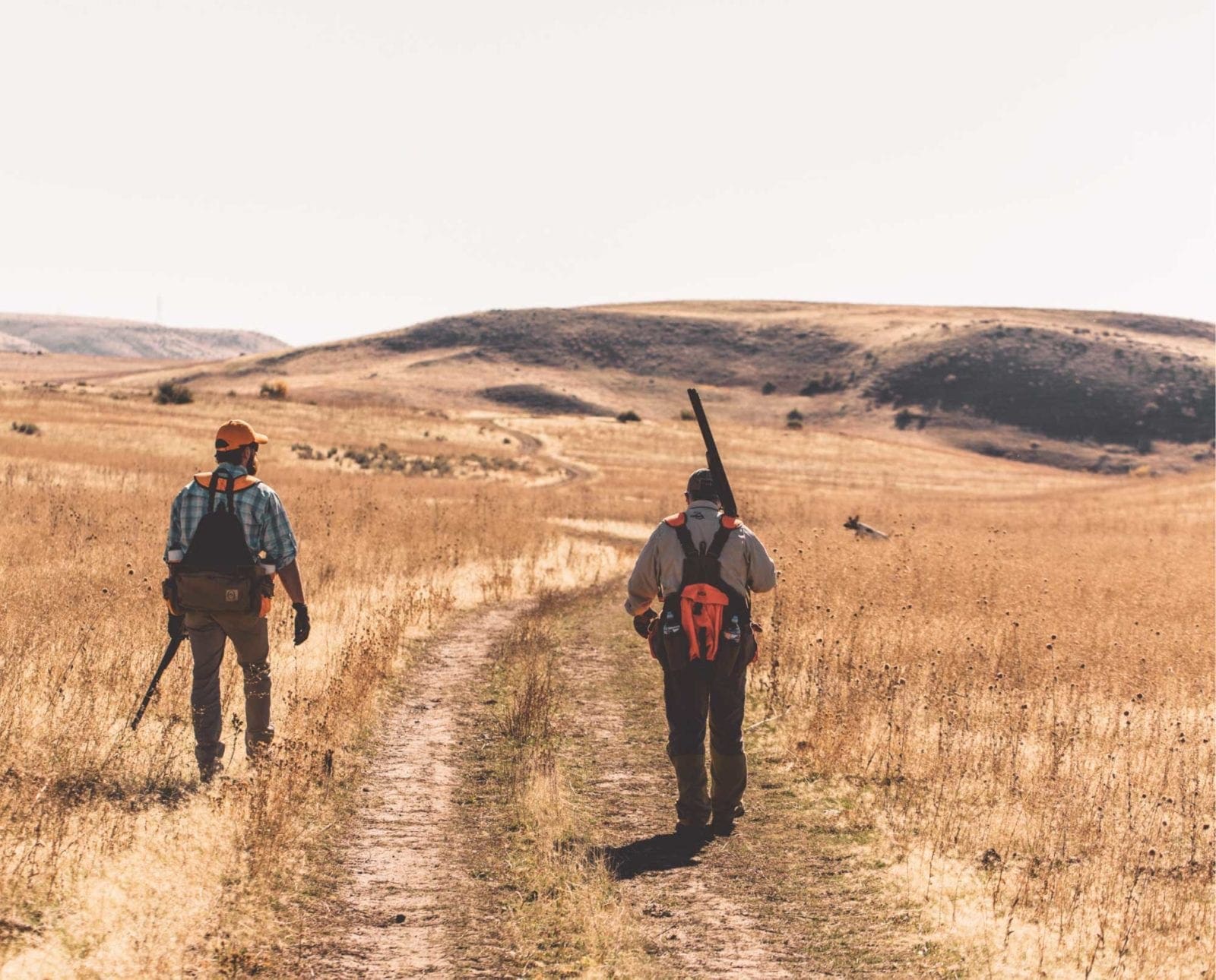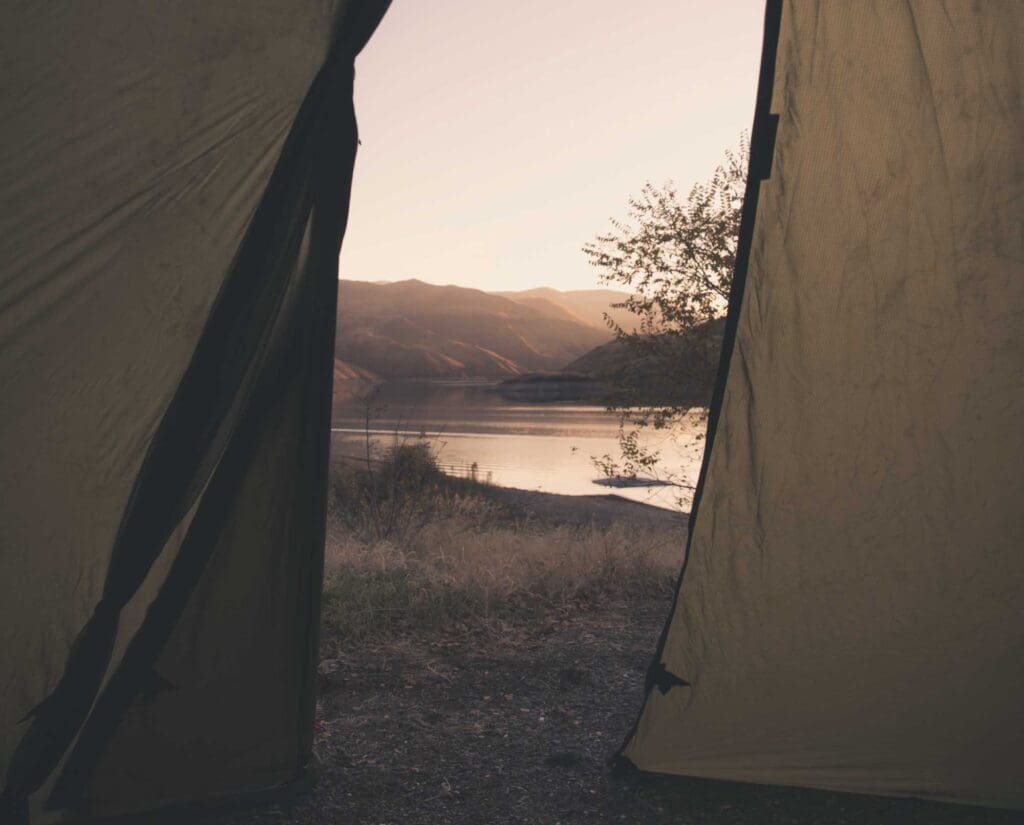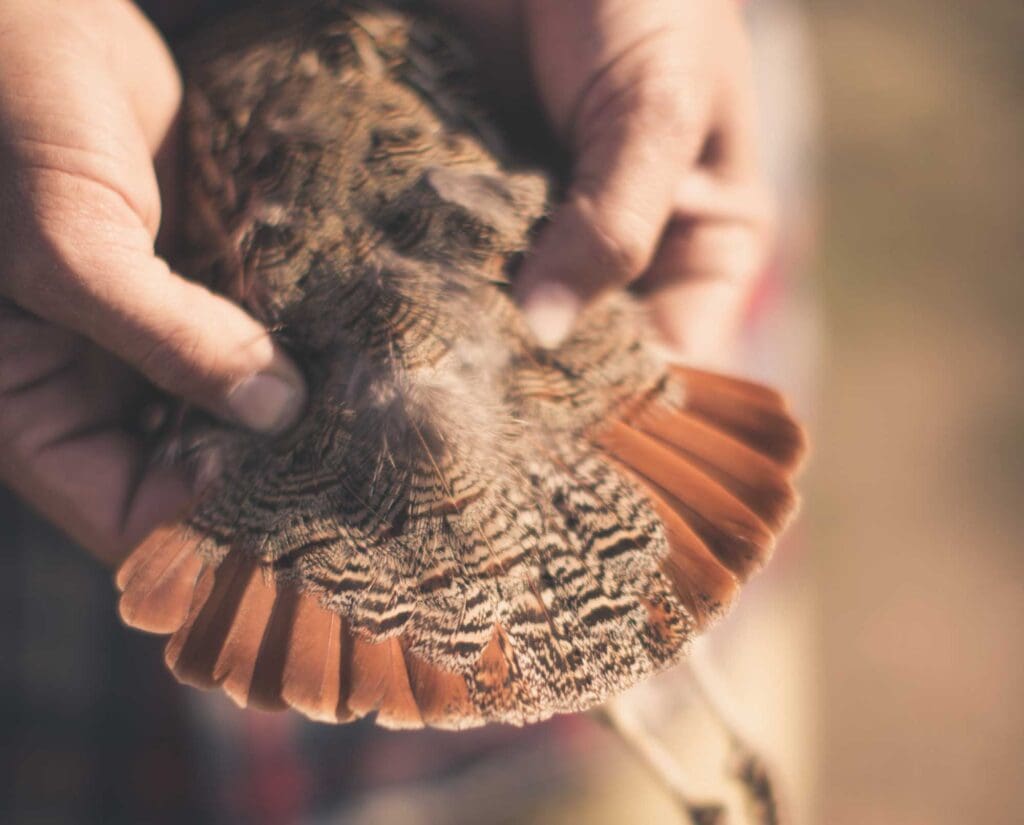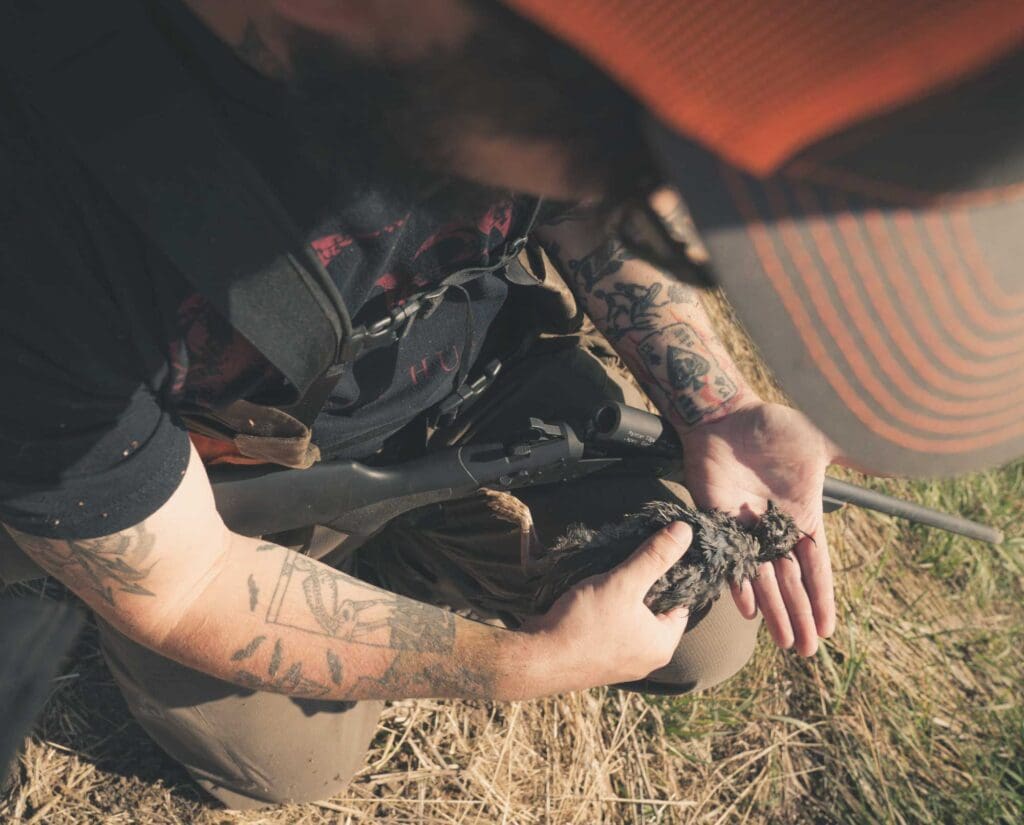Home » Hunting Rules, Licenses, and Seasons » Bird Hunting in Idaho: Grouse, Quail, Chukar, and More
Bird Hunting in Idaho: Grouse, Quail, Chukar, and More

A.J. DeRosa, founder of Project Upland, is a New England…
Who knows how many grouse are hiding in Idaho. Isn’t it time you found out?
The dog circled ahead and disappeared into the thick bushes at the edge of a field. Not too far off, I heard the gentle flow of water in a clear brook as the dog’s footsteps vanished. “Is he on point?” I wondered as I held my on-loan, single-shot 20-gauge youth shotgun, ready for the rise of California quail. Determined to check this box, I knew I wouldn’t have another chance to bird hunt in Idaho anytime soon.
A side note: I had never experienced a covey rise before that day, leaving me without a reference point, as I had yet to pursue bobwhite quail or Hungarian partridge. The thrill I felt was incomparable as the bushes erupted with the rhythmic rise of a covey of California quail, which darted away in a lightning-fast flush. I squeezed the trigger on my single barrel, only to have my shot miss its target, understanding now what covey panic truly meant.
I persuaded myself to focus on a single bird. As I continued walking to the end of the farm field with the dog to my right, a small covey suddenly took flight, and I managed to take down a single male valley quail. The taste of California quail proved as delightful as the experience itself. The relaxed hunt and the ease of securing a meal made me yearn for populations of these valley quail to exist back East
More than 50 million acres of Idaho is publicly-owned. That certainly puts the state in the top ranks for public land and national parks, but what does Idaho have? Quite a bit, actually. Idaho is one of the most mountainous and forested states in the country, with all sorts of treasures waiting to be discovered. And few other states have five different kinds of grouse all within reach. There are parts of the Selway-Bitterroot Wilderness still left untouched by humanity. The parts of Idaho that have been touched can still be difficult to access. That is why programs like Access Yes! exist, which so far has opened about 400,000 acres of private land and 500,000 acres of public land.
| Game Species | Dates | Daily/Possession Limits | Notes |
| Dusky (Blue) Grouse – Area 1 | Aug. 30, 2024 – Jan. 31, 2025 | 4/12 (combined forest grouse) | Forest grouse. |
| Dusky (Blue) Grouse – Area 2 | Aug. 30 – Dec. 31, 2024 | 4/12 (combined forest grouse) | Forest Grouse |
| Spruce Grouse – Area 1 | Aug. 30, 2024 – Jan. 31, 2025 | 4/12 (combined forest grouse) | Forest Grouse |
| Spruce Grouse – Area 2 | Aug. 30 – Dec. 31, 2024 | 4/12 (combined forest grouse) | Forest Grouse |
| Ruffed Grouse – Area 1 | Aug. 30, 2024 – Jan. 31, 2025 | 4/12 (combined forest grouse) | Forest Grouse |
| Ruffed Grouse – Area 2 | Aug. 30 – Dec. 31, 2024 | 4/12 (combined forest grouse) | Forest Grouse |
| California (Valley Quail) – Area 1 | Sept. 21, 2024 – Jan. 31, 2025 | 10/30 (combined quail species) | |
| Bobwhite Quail – Area 1 | Sept. 21, 2025 – Jan. 31, 2025 | 10/30 (combined quail species) | |
| Gambel’s Quail | CLOSED | NONE | |
| Mountain Quail | CLOSED | NONE | |
| Chukar | Sept. 21, 2024 – Jan. 31, 2025 | 8/24 (combined with huns) | entire state |
| Hungarian (Huns) Partridge | Sept. 21, 2024 – Jan. 31, 2025 | 8/24 (combined with chukar) | entire state |
| Sage Grouse | Sept. 21 – Oct. 31, 2024 | 2/2 | Special Permit Required |
| Sharp-tailed Grouse – Area 1 | Oct 1 – 31, 2024 | 2/6 | Permit validation required. |
| Pheasant (Resident)- Area 1 | Oct. 12 – Dec. 31, 2024 | 3/9, cocks only | Permit validation required. |
| Pheasant (Nonesident)- Area 1 | Oct. 17 – Dec. 31, 2024 | 3/9, cocks only | Permit validation required. |
| Pheasant (Resident)- Area 2 | Oct. 19 – Nov. 30, 2024 | 3/9, cocks only | Permit validation required. |
| Pheasant (Nonesident)- Area 2 | Oct. 24 – Nov. 30, 2024 | 3/9, cocks only | Permit validation required. |
| Pheasant (Resident)- Area 3 | Oct. 19 – Dec. 31, 2024 | 3/9, cocks only | Permit validation required. |
| Pheasant (Nonesident)- Area 3 | Oct. 24 – Dec. 31, 2024 | 3/9, cocks only | Permit validation required. |
| Pheasant (Youth) | Oct. 5 – Oct. 11, 2024 | 3/9, cocks only | Permit validation required. |
| Mourning Dove | Sept. 1 – Oct. 30, 2024 | 15/30 combined with white-winged | HIP Permit Required |
| White-winged Dove | Sept. 1 – Oct. 30, 2024 | 15/30 combined with white-winged | HIP Permit Required |
| Eurasian Collared Dove | No Closed Season | No Limits | |
| Crow | Oct. 27, 2024 – Feb. 28, 2025 | No Limits |
The bird hunting season dates, game bird species available, and other information is subject to change. The article may not reflect this. Please visit the Idaho Department of Fish and Game for the most up to date information on bird hunting in Idaho. This information was last updated September 11, 2024.
Forest Grouse Hunting in Idaho
Ruffed grouse in Idaho differ from those found in other regions. They display less skittishness and are not subjected to the same pressures as their counterparts in the East. Depending on the source, their behavior may bear more resemblance to spruce grouse, another species present in Idaho. Additionally, the mountains of Idaho are inhabited by dusky grouse, often referred to as blue grouse. This further contributes to the diverse array of habitats that Idaho provides for upland birds.
Area 1 for forest grouse is defined as: “Boundary, Bonner, and Kootenai counties, portions of Latah and Clearwater counties in management units 6 and 9, and Benewah and Shoshone counties, except for those portions in management units 8, 8A, 10, and 10A.
Area 2 for forest grouse is defined as: “Remainder of the state”

Chukar Hunting Idaho
If chukar hunting in the Pacific Northwest is your aim, then Idaho likely offers some of the finest chukar hunting opportunities. These birds favor arid regions with sagebrush, and a substantial portion of the population calls southern Idaho home. Numerous individuals journey from different states to partake in hunting the iconic Hells Canyon for the renowned “devils bird,” seeking to ascertain whether the location and the species align with their reputation.
Hungarian (Huns) Partridge Hunting Idaho
Hungarian partridge, a highly adaptable non-native wild species, thrive in Idaho’s varied landscapes. Abundant populations can often be spotted in numerous areas, frequently alongside chukar country. The ample hunting season for Hungarian partridge coincides with chukar hunting, commencing in September and extending through January of the subsequent year. For those exploring the hunting opportunities in Idaho, targeting this species is an absolute must.

Sage Grouse Hunting in Idaho
Sage grouse hunting opportunities are highly restricted in Idaho, necessitating a special tag for participation. These tags become available for purchase starting on August 1st and are allocated on a first-come, first-served basis. A total of 5,091 tags have been designated for the year 2024, distributed across 12 distinct zones. To access the most up-to-date details regarding zone allocation, season dates, and related information, I encourage you to visit the Idaho Fish & Game website.
Ring-Necked Pheasant
The population of ring-necked pheasant in Idaho has declined sharply in recent years. If you really want to find pheasant while bird hunting in Idaho, you might have to look hard. Southwest Idaho might be good, as well as the southeast.
There are three separate areas defined for pheasant hunting and the season dates vary by area. There is a daily limit of three birds (cocks only), with special rules and permits necessary for Wildlife Management Areas (WMA).
Area 1 for pheasant is defined as: “Benewah, Bonner, Boundary, Clearwater, Idaho, Kootenai, Latah, Lewis, Nez Perce, and Shoshone counties.”
Area 2 for pheasant is defined as: “Bannock, Bear Lake, Bingham, Bonneville, Butte, Caribou, Clark, Custer, Franklin, Fremont, Jefferson, Lemhi, Madison, Oneida, Power, and Teton counties.”
Area 3 for pheasant is defined as: “Includes all parts of the state NOT included in areas 1 and 2.”
Columbian Sharp-Tailed Grouse
Idaho proudly hosts one of the largest populations of Columbian sharp-tailed grouse in the United States. This subspecies distinguishes itself from the sharp-tailed grouse inhabiting the prairies of the Dakotas and Montana. Promising locations to explore include the southeastern region, encompassing Power and Oneida counties. Hunting opportunities for sharp-tailed grouse are particularly favorable in fields under the Conservation Reserve Program.
Area 1 for sharp-tailed grouse is defined as: “Bingham, Bonneville, Clark, and Jefferson counties east of Interstate 15, Bannock County east of Interstate 15 and south of Interstate 86, Power County south of Interstate 86, and those portions of Cassia County east of Interstate 84 and west of Interstate 84 south of the Malta-Sublett Road and east of the Malta-Strevell Road, Bear Lake, Caribou, Franklin, Fremont, Madison, Oneida, and Teton counties.”
Area 2 for sharp-tailed grouse is defined as: “Remainder of the state: CLOSED.”
There is a daily bag limit of 2 birds. You will also need to purchase a separate permit to hunt sharp-tailed grouse in Idaho.

Quail Species
While Idaho has both bobwhite quail and California (valley) quail, you’ll probably have an easier time finding California quail. Their range goes from southern Idaho all the way up to the beautiful Palouse region in the Idaho Panhandle bordering Washington. They prefer to be near streams or rivers that have dense cover for them to escape predators.
The daily bag limit is 10 in aggregate. Note that there is no legal hunting season for mountain or Gambel’s quail. Quail hunting is not open state-wide; check regulations for the legal areas to hunt quail.
Area 1 for quail is defined as: “Ada, Adams, Benewah, Blaine, Boise, Bonner, Boundary, Camas, Canyon, Cassia, Clearwater, Elmore, Gem, Gooding, Idaho, Jerome, Kootenai, Latah, Lewis, Lincoln, Minidoka, Nez Perce, Owyhee, Payette, Shoshone, Twin Falls, Valley, and Washington counties.”
Area 2 for quail is defined as: “Remainder of the state”
Dove Hunting in Idaho
Idaho offers excellent dove hunting opportunities for various species of doves. There are two native species: the mourning dove and the white-winged dove, along with the non-native Eurasian collared dove. Hunting doves requires a HIP permit. The Eurasian collared dove has no closed season or limit, but a valid hunting license is still required.

Idaho Game Bird Transport Rules
All game birds in Idaho must have either one fully-feathered wing or the head naturally attached during transportation. You can check out this article on how to properly clean a bird for transport: “The Many Regulations and Laws of Transporting Game Birds.”
Related Conservation and Non-Profit Organizations for Idaho Bird Hunting
North American Versatile Hunting Dog Association
The Hunter Safety Course and Dog Training for Bird Hunting in Idaho
Anyone born after December 31, 1974, will need to complete an approved hunter education course before purchasing a license. There is an internet course and field day option available for anyone 9 years old or older. Idaho also offers a hunting passport, which lets any first-time hunters older than 8 hunt without having to complete an education course. They will need to be accompanied by an adult mentor.
You will need a sport dog and falconry training permit in order to train your dog for bird hunting in Idaho if captive game birds will be released.
License Requirements for Bird Hunting in Idaho
In addition to the fee table below, hunters must pay an Access-Depredation Fee for the first annual license purchased each year. It is not applicable to additional or daily licenses. The Access-Depredation Fee is $5 for resident adults and $10 for non-resident adults; $2 for resident youth and $4 for non-resident youth.
| License* | Resident | Non-resident |
| Hunting – annual | $15.75 | $185.00 |
| Small Game Hunting | N/A | $141.75 |
| Non-resident 3 day small game | N/A | $71.75 |
| Junior hunting (10-17 yrs) | $8.25 | $31.75 |
| Sharp-tailed grouse permit | $5.75 | $17.75 |
| Sage Grouse Permit | $22.75 | $74.25 |
| Upland game bird permit (required for pheasant hunting on WMAs) | $28.75 | $56.75 |
* License fees, laws, and availability is subject to change. For the latest information please go to https://idfg.idaho.gov/rules/upland The last update of this information was on September 11, 2024.
A.J. DeRosa, founder of Project Upland, is a New England native with over 35 years of hunting experience across three continents. His passion for upland birds and side-by-side shotguns has taken him around the world, uncovering the stories of people and places connected to the uplands. First published in 2004, he wrote The Urban Deer Complex in 2014 and soon discovered a love for filmmaking, which led to the award-winning Project Upland film series. A.J.'s dedication to wildlife drives his advocacy for conservation policy and habitat funding at both federal and state levels. He serves as Vice Chair of the New Hampshire Fish & Game Commission, giving back to his community. You can often find A.J. and his Wirehaired Pointing Griffon, Grim, hunting in the mountains of New England—or wherever the birds lead them.




Blue grouse are found throughout the mountains of Idaho, not just northern Idaho. I have hunted blue grouse a few miles north of the Nevada border. Your comments are grossly too vague.
There’s five different species of Grouse in Idaho: Mountain Grouse (Ruffed, Dusky, Spruce), Greater Sage-grouse & Columbian sharp-tailed grouse. All these grouse are native birds. Then there’s the invasives: Pheasants, Chukar, Hungarian Partridge & Quail. There’s also Dove season as well as Turkey seasons, giving hunters an opportunity to harvest 11 different species of birds in the state. There’s also no closed season on Eurasian Collared Doves, another invasive species.
A sport dog training permit is only required if you are releasing game birds (chukar, pheasants, ducks, etc.) in the course of training. You can run your dog on wild birds and shoot pigeons to your heart’s content without needing to a permit.
Montana has better sharptail country, Nevada has better Chukar country, the Dakotas are the best for pheasants and you should go to Arizona for quail and doves. You should check out those states first!
Great information thank you!
But no state has as many within easy driving distance AND waterfowl (now including swan) AND fishing that is awesome.
Hunters should be aware that the Idaho legilature passed a new trespass law that removes the posting requirement for private land and imposes severe penalties for even first time offenders. If you come here, be damn sure you know where you are at all times.
Is there any chance for nonresidents to get permission for private land bird hunting?